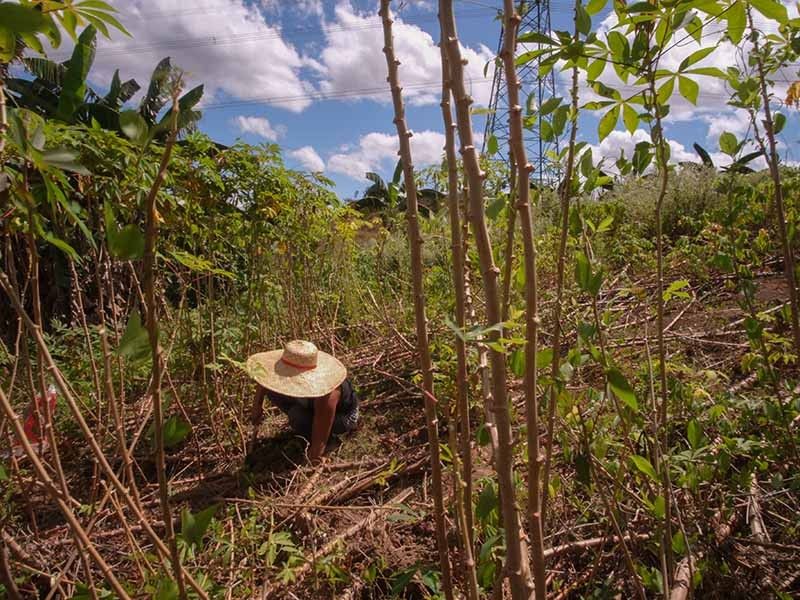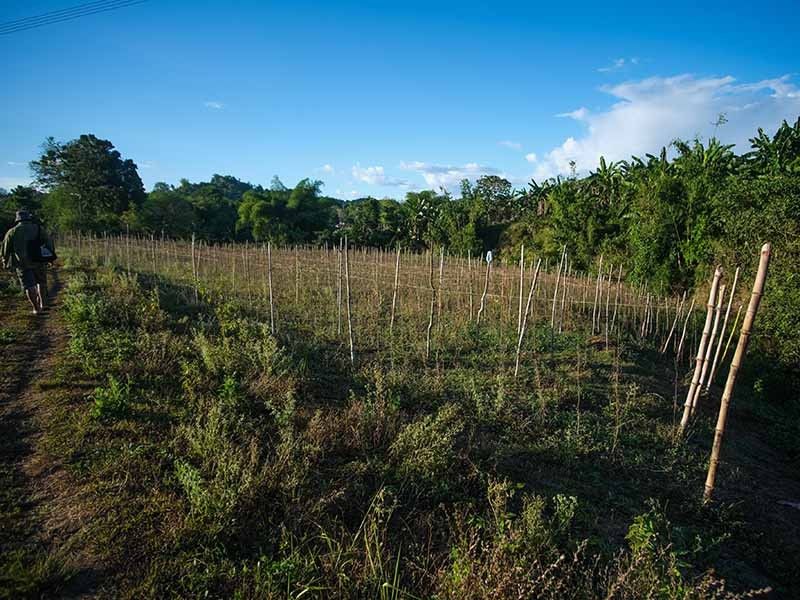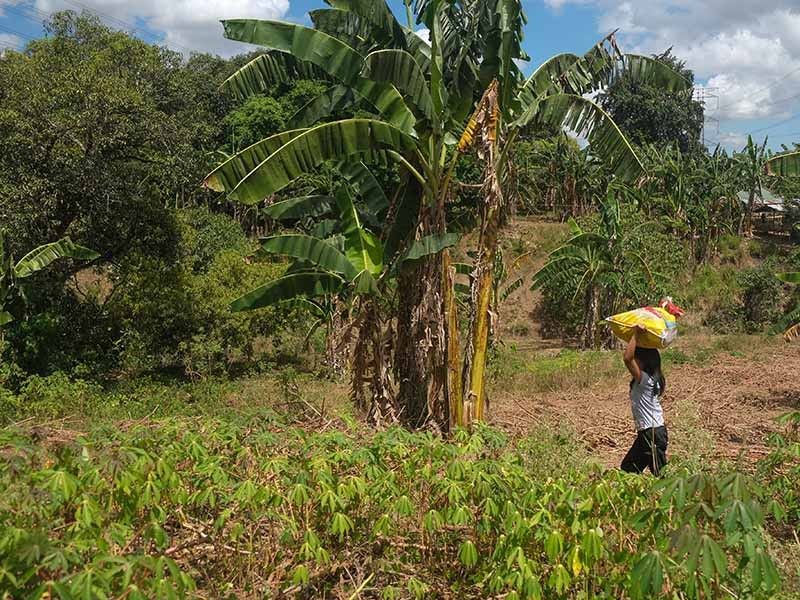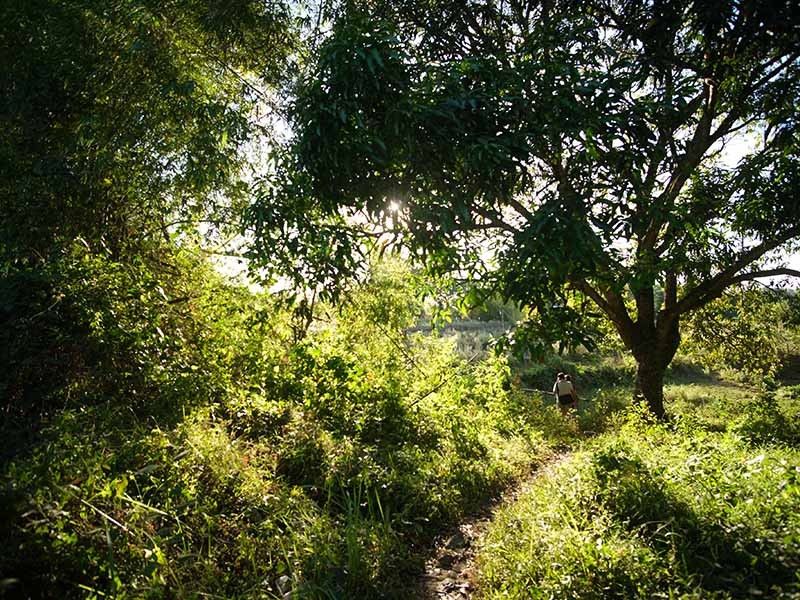Along the path of MRT-7, tension over land use and food security

BULACAN, Philippines — Situated two hours away from Quezon City, is San Jose del Monte, Bulacan, an agricultural area also known as the "Balcony of the Metropolis."
The Metro Rail Line Transit 7, or MRT 7, which is expected to be partially operational by the fourth quarter of 2022, begins at San Jose del Monte City and ends at the North Triangle Common Station at North Avenue, Quezon City.
Plans to convert the 3,500-hectare agricultural land to real estate and commercial areas escalated around the 2000s, as the news of the construction of the MRT-7 also entailed urbanization.
In 2017, businessman Gregorio "Greggy" Araneta III announced plans to build the "first central business district (CBD) of Caloocan" once the MRT-7 is in place.
And while the CBD and the MRT-7 may suggest ease for businesses and commuters, farmers and advocates say this "development" will be marred by blood and will be at the expense of Filipino farmers and the nation’s food security.
'Agrarian reform designed to fail'
Farmers in San Jose del Monte (SJDM) face a 77-year land struggle for over 1,000 hectares of productive land: 588 hectares of agricultural lands in Barangay Tungkong Mangga, 311 hectares in Barangay San Isidro, more than 84 hectares in Sitio Ricafort, and more than 70 hectares in Sitio Dalandanan.
Redo Peña, a farmer and a member of Tungkong Mangga Upland Farmers Association Inc (TMUFAI), recalled that families started to settle in the area in 1945. They made the area productive by planting rice, corn, coffee and fruit crops.
By 1987, the Comprehensive Agrarian Reform Program (CARP), an act to redistribute private and public agricultural lands to farmers covered land in San Jose del Monte.
However, starting in the 1990s, peasants have been facing real estate and land development tycoons in land disputes.
"Guards started to visit us, telling us that our farms will be converted into real estate use. We were wondering how this happened because no consultation occurred," narrated Peña, a resident of San Jose del Monte since the 1960s.
His organization, TMUFAI, later learned about the 1992 DAR conversion order and appealed against it.
"Under CARP, we were granted a Certificate of Land Ownership Award (CLOA), a document that the land has been awarded to the beneficiary, but DAR’s flawed inspection concluded that our land had no crops and no farmers so the CLOA was canceled," said Peña.
The land struggle against the business giants persisted; this time, Peña said, armed goons and military forces started to surround their homes. The land dispute involved violent demolitions and even the Tungkong Mangga Massacre that killed four farmers and wounded two in 1998.
In 2015, Peña said, he was visited by Greggy Araneta himself. Peña’s neighbors said the scene was "straight from a telenovela" because he arrived in a luxury car with security guards. However, the farmer did not face the businessman because of the fear of being killed.
Araneta Properties Inc. has yet to respond to a request for comment on the land dispute and related incidents. This story will be updated as soon as they respond.
"CARP only paved the way for land-grabbing instead of ensuring our right to till it," said Peña.
Similar displacement has happened to locals of Boracay island, Tacloban City, and Siargao island.
The indigenous people of Boracay were displaced during the island’s rehabilitation. After typhoons Yolanda and Odette, Tacloban and Siargao fisherfolk were not allowed to return to their homes by the sea even as conglomerates benefitted by reconstructing areas to turn them into an ecotourism destination.
Rosario Guzman of IBON has described this as “disaster capitalism.”
Productive land for farmers, 'non-viable for agricultural use' for DAR

The dispute did not prevent San Jose del Monte farmers from exhausting ways to prove their right to their land. Despite multiple quashed CLOAs, farmers continued to appeal for their ownership.
"Today, DAR is saying that our lands are over the 18% slope,” said Rose, another farmer from San Jose del Monte.
According to DAR, "lands which are above the 18% slope are exempt from CARP" since they are "non-viable for agricultural use."
However, for Rose and her neighbors, this isn’t the case.
"Kung hindi mapagtatamnan ang lupa namin, eh anong tinatawag mo diyan? (If our land is non-arable then what do you call that?)," Rose pointed to their field of string beans.
"How could they exempt our land from CARP when we have been making a living from harvesting vegetables in this land for decades?" she added.
San Jose del Monte farmers also regularly participate in "Bagsakan" a series of agricultural fairs in Metro Manila to sell their organically-grown produce. This farmer’s market initiative started in 2018 to bring products directly to consumers.

Some farmers are also employed as agricultural workers in what they call "Araneta’s farm."
"Yung tinatanim namin dun pang-mayaman. Yung lettuce ba, yung binabalot nila sa baboy, (What we plant there is for the rich. Lettuce, the one they use to wrap pork belly)," said Ramil* who is also an agricultural worker.

Daily, he is paid P450 for working from 6 a.m. to 5 p.m., six days a week. He described the amount as "hindi nakakabuhay," not enough to make a living.
On his days off, he works in their communal farms where they harvest bananas, sweet potatoes and cassava on their own. The pandemic has made it harder for them to sell their produce, but he said it was better than working for someone else’s profit.
'The fight for food security is bloody'

Twenty-four years after the “Tungkong Mangga Massacre," bullets were once again heard in their barangay.
"The bullets sounded like fireworks, we were all screaming, but we couldn’t hear anything because they were firing everywhere," said Marie*, a peasant advocate from Sama-samang Artista para sa Kilusang Agraryo, an alliance of cultural workers advocating for genuine agrarian reform.
"They fired in different directions — upward, towards the ground, facing the ones who were running," she recalled.
"There was a farmer who was punched in the stomach and beaten by a gun when he was just about to run after his little kid," she added.
On January 28, 2022, eight peasant advocates visited Tungkong Mangga to conduct a fact-finding mission two days after goons demolished houses, including Peña’s.
"They threatened to finish us. An armed man fired the gun right beside my ear. I thought it was the end of me," said another victim.
Over 28 people, including minors and the elderly, were at the scene. One of the two people who were injured was a journalist.
"What triggered the goons was my camera because it was recording the accounts of the farmers whose homes had been demolished. They grabbed the camera away from me, punched me, and while that was happening, I saw other volunteers being shouted at," said journalist and filmmaker Manuel Garcellano.
"They took all my equipment away, so no footage of the incident has been preserved," he added.
The only way the victims were able to visualize the harassment was through a comic strip.
Rafael Mariano, former agrarian reform secretary, said that both the demolitions done on January 26 and 28 were illegal because the farmers weren’t consulted, they didn’t receive a notice of demolition, and there are no plans for their relocation.
"The goons took everything, even the chicken eggs. They left after 30 minutes as if nothing happened," Marie said.
"We have no more houses to return to. The MRT-7 is still being built, but we are already being displaced," Peña said.
Ramil also said they haven’t even met the buyer of their land, what they have only been told was they will be evicted and only the caretaker will be paid.
"Parang trinato kaming aso (They treated us like dogs). Where will we go after they take our land away from us?" Ramil said.
Peña said his kids can’t sleep at night because of the trauma of the demolition.
'We did nothing wrong, so why are we the ones running?'

The week after the violent encounter, instead of cowering in fear, Rose went back to the field and still harvested vegetables.
Not because nothing happened, but because she had to work so that her family could eat and put food on people’s tables.
“We did nothing wrong, so why are we the ones running?” she asked.
“We support development, but we are against 'development' that excludes most Filipinos and only benefits the ones with money,” she said.
“Sometimes, I think I should just go on TikTok just so people would notice the farmers’ struggles. But I can't harvest crops while dancing,” she added trying to lighten the situation.
“I hope people could listen to us because we’re not just fighting for our right to till our land, we’re also fighting so that people can eat.”
--
*Victims asked for their names to be changed to protect their identity
Geela Garcia is a freelance multimedia journalist and peasant advocate based in Manila.
- Latest
- Trending
































